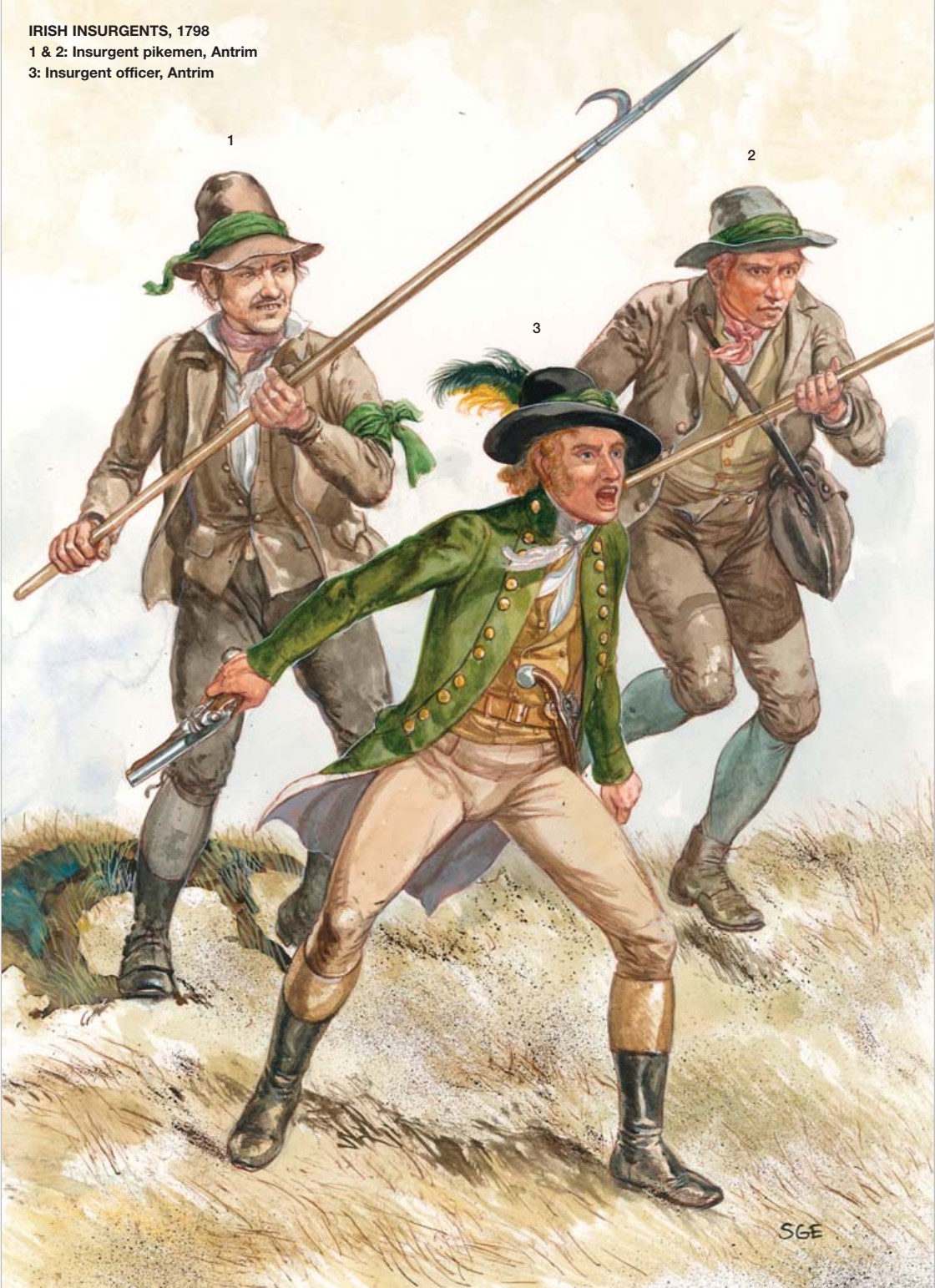“Charge of the 5th Dragoon Guards on the insurgents – a recreant
yeoman having deserted to them in uniform is being cut down” (William
Sadler II)

BATTLE OF VINEGAR HILL BY J. HARDY, 1798
This plan of Vinegar Hill near Enniscorthy, County Wexford, shows the
position of the armies on 21 June 1798. The key battle in the Irish Rising of
1798, this was a struggle won by the larger and better-armed side. The
poorly-led rebels in Wexford concentrated at Vinegar Hill, losing the strategic
initiative and allowing the British to land reinforcements near Waterford from
16 June. Lieutenant-General Gerard Lake was able to concentrate an army of
20,000 men and a large artillery train. He attacked his 9,000 opponents on 21
June, using his artillery to devastate them. The rebels fought for two hours,
suffering heavy casualties, and finally retreated when their ammunition ran
out. The rebel pikemen were shot down. Their cohesion lost, the rebels suffered
heavily in subsequent government punitive operations. The rising had been
defeated.
The Society of United Irishmen was founded in 1791, inspired
by the French Revolution. The organization’s purpose was to secure
parliamentary reform and legal equality for all Irish, and it was led by
Belfast Presbyterian merchants and Dublin intellectuals, most notably Wolfe
Tone (1763-98) and James Napper Tandy (1740-1803). The United Irishmen garnered
support among Presbyterian farmers in Ulster and among Roman Catholic peasants
generally.
At first the United Irishmen advocated reform by peaceful
means, but, after war broke out in 1793 between Great Britain and France, the
society began to espouse outright revolution. In April 1794, it even secured
promises of aid from the French for any revolution. When British authorities
acted harshly to suppress the United Irishmen, the organization went
underground and became avowedly militant, entirely determined to foment
rebellion.
Bolstered by anticipation of promised French aid, armed
Irish mobs seized control of County Wexford, but were beaten back by British
troops commanded by Gerard Lake (1744-1808) at the Battle of Vinegar Hill on
June 21, 1798. In the meantime, Wolfe Tone led a French expeditionary force
from the Continent only to be intercepted by a British squadron off Lough
Swilly, County Donegal. The squadron easily overpowered the force, and Tone,
captured, was tried and convicted of treason. He committed suicide before the
court’s sentence-death by hanging- could be carried out.
Due to its natural shelter and its depth, the lough was an important
naval port. In October 1798, immediately prior to the outbreak of the
Napoleonic wars, a French fleet carrying Wolfe Tone of the United Irishmen,
plus troops to assist in 1798 rebellion, was intercepted and defeated in a
naval battle at the entrance to Lough Swilly. Subsequently Tone was captured
and taken ashore at Buncrana on the east side of the Swilly.
A Martello tower that sits on the banks of Lough Swilly.
A subsequent reassessment of the threat of invasion led to the building
of a series of fortifications guarding the different approaches and landing
points within the lough which were completed between 1800 and 1820. Martello
towers were built around 1804 to defend the approaches to Derry. The six on the
lough cost €1,800 each, were armed with smoothbore cannon, firing round shot
and were completed in six months.
With the defeat at Vinegar Hill, the quelling of two other
local revolts, and the death of Tone, the United Irishmen’s revolt collapsed.
The other principal rebel leader, Tandy, fled into French exile. In 1801, Great
Britain was united with Ireland as the United Kingdom.
The Wexford rising, as it was known, which began 26-27 May,
was more serious. Here the United Irishmen were better organized and were led
by charismatic local priests as well as some liberal Protestant gentry. The
Wexford insurgents defeated government forces at Oulart Hill and captured the
towns of Enniscorthy and Wexford, where they established a rudimentary
administration. They tried to spread the rebellion into other counties but were
heavily defeated at the battles of New Ross (5 June) and Arklow (9 June). The
tide turned completely against the rebels with their defeat at the Battle of
Vinegar Hill (21 June). Some leaders like Michael Dwyer (1771-1826) retreated
with remnants of the rebel army into the Wicklow mountains, maintaining a
guerrilla campaign until 1803.
APPROXIMATE MAXIMUM NUMBER OF MEN UNDER ARMS: England,
100,000; Ireland, 40,000; France, 3,000 CASUALTIES: English, 1,500 killed in
battle; 10,000 died of disease; Irish, 7,900 killed, wounded or captured at New
Ross, Vinegar Hill, Castlebar, Ballynamuck, and Killala. Irish total combatant
and noncombatant deaths estimated at 50,000. At Lough Swilly, French losses
included 425 killed and 1,870 captured.
Roy Foster described the 1798 rising as `probably the most concentrated episode of violence in Irish history’. There were mass atrocities perpetrated by both sides, about 30,000 people died and over £1 million worth of property was destroyed. After this rebellion and that of Robert Emmet in 1803 (III), the government extended its military precautions. Among defensive measures taken was the building of military roads, including one across the Dublin and Wicklow mountains. During the Napoleonic wars, increased fears of foreign invasion led to the widespread construction of Martello towers along the Irish coastline. Apart from the destruction of the United Irishmen and the consequent discrediting of the ideals of fraternity and religious equality that had been at the base of its thinking, an immediate consequence of the rising was to increase pressure for union between Ireland and Britain. As the final irony, the main result of the 1798 rising was to bind Ireland closer to Britain for more than another century.